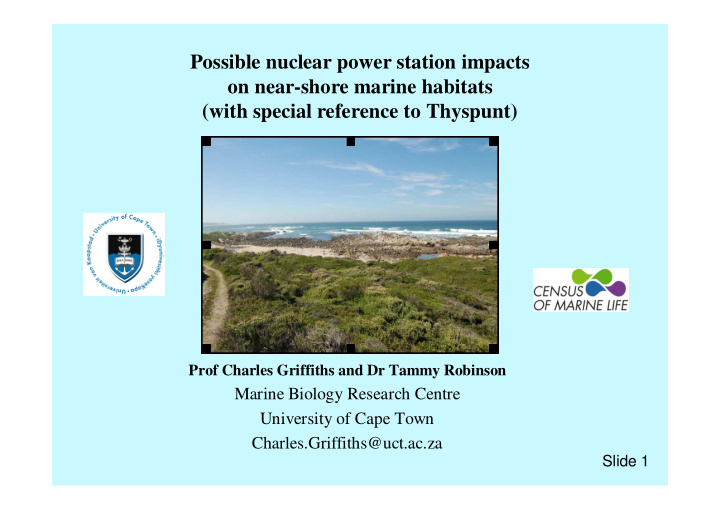



Possible nuclear power station impacts on near-shore marine habitats (with special reference to Thyspunt) Prof Charles Griffiths and Dr Tammy Robinson Marine Biology Research Centre University of Cape Town Charles.Griffiths@uct.ac.za Slide 1
Background: Thyspunt lies in the centre of the large, relatively uniform Warm-temperate ‘Agulhas Bioregion’ of South Africa Slide 2
This bioregion is considered to be ‘well protected’ (in terms of protected areas) and is the least threatened coastal biozone in the region (in terms of exploitation pressure, mining etc) B iozone Threat S tatus B iozo ne P ro tection S tatus C ritica lly endan gered W ell p ro tecte d E ndangered M od era te ly pro te cted V uln erable P o orly p ro te cte d Intertidal Least thre atened In te rtidal H ardly protected S hallow p hotic S upratid al S h allow pho tic S up ratidal Z e ro p ro te ction D eep pho tic D e ep pho tic S u b ph otic S ub ph otic Source: SA State of the Environment Report 2004 Slide 3
It lies in an area of high overall species richness and endemicity (bar 15), but contains very few unique or range-restricted species (lower fig.) All groups combine Removed endemic Endemics 1400 Species per 100 km 1200 stretch 1000 1= Orange R 800 8= Cape Town 600 15 = Thyspunt 400 16= Port Elizabeth 200 24= Durban 0 1 2 3 4 5 6 7 8 9 10 11 12 13 14 15 16 17 18 19 20 21 22 23 24 25 26 27 28 Distance around the coast (100 km un 120 100 Range-restricted species 80 Per 100 km stretch 60 (range <300km) 40 20 0 Slide 4 1 2 3 4 5 6 7 8 9 10 11 12 13 14 15 16 17 18 19 20 21 22 23 24 25 26 27 28 Distance around coast (100 km un
Potential nuclear power-station impacts on marine environment: 1. Entrainment and death of fish and plankton in intake water 2. Death of local fauna as a result of construction work, spoil dumping, etc 3. Release of heated water and/or brine from desalination plants 4. Changes in current patterns due to breakwaters, etc 5. Creation of habitat (e.g. hard substrata where only beach existed before) 6. Access control, leading to less angling and disturbance (conservation areas) Note: Release of radio-isotopes into the sea is not considered a threat, as cooling water never comes into contact with the reactor. Slide 5
Entrainment of marine organisms in cooling water: - Pumping, plus chlorination, of cooling water at Koeberg results in mortality of 28% phytoplankton and 43-68% of zooplankton in pumped water - Almost no larger fish or other marine species are entrained and killed -Wider impacts undetectable, given the much larger natural water flow through the area and the short doubling time of plankton in the cooling water Slide 6
Construction and dumping: (Regarded as the main environmental impact of concern) -Tunneling to lay water intake pipes and laying of outfall pipes will disrupt limited areas of seabed - Dumping of spoil can be expected to smother bottom- dwelling species over area approx 3 km 2 and may affect chokka squid spawning areas, but only by a few % -This effect will be focused within the construction phase and will be localised and of limited duration (a few years) - Recovery (spoil dispersion and colonisation) can be anticipated to take place over several years Slide 7
Release of heated water: -Volume minimal in comparison with natural flows (ca 80 m 3 .sec at Koeberg vs 60 million m 3 .sec for Agulhas Current) - No temperature elevation >2 o C detected more than 1 km from outfall at Koeberg - Warmed plume water floats, so does not effect bottom–dwelling species - Twice yearly surveys at Koeberg have revealed no detectable changes in biota, even within 1 km radius - Any warming at Thyspunt is taking place in context of a long term cooling trend in region, as depicted below. Sea temp changes 1985-2007 Slide 8
Release of desalination brine: - More problematic than heating, as heavier than seawater, so sinks - Could result in impacts during construction phase, but over limited area and limited duration of this phase - During operational phase will be mixed with heated water, resulting in high dilution and reduced density, impact expected to be undetectable Changes in current pattern and habitat type: - Impacts trivial at this site, as hard substrates and complex shore topography already present and no stilling basin to be constructed - Any additional hard substratum simply provides more habitat for attached species Controlled access: - Results in enhanced fish stocks and diffusion of protected fish into adjacent angling areas, but as this particular site is already restricted, little additional benefit is to be gained Slide 9
Overall marine impacts - conclusions: - Limited negative impacts expected during construction phase, mainly due to release of saline water and construction activities (excavation, dumping of spoil, etc). - Area of impact a few km 2 ( South Africa’s EEZ = 1 million km 2 ) - Recovery expected to be measured in years (not decades) -Marine impacts during operational phase expected to be undetectable, as is currently the case for Koeberg -Positive impacts expected from conservation of site expected to continue Slide 10 End
Recommend
More recommend